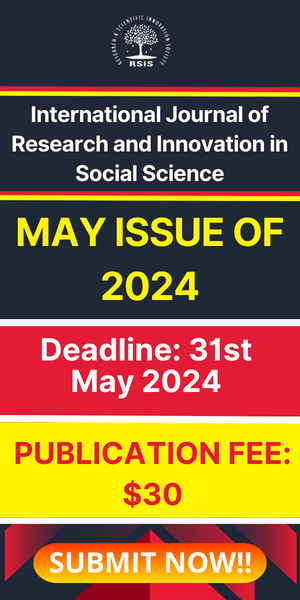A study of Dinophysiales and Prorocentrales of Atlantic Ocean, Gulf of Guinea, Nigeria
- June 20, 2023
- Posted by: rsispostadmin
- Categories: Biochemistry, Biotechnology, IJRIAS
A study of Dinophysiales and Prorocentrales of Atlantic Ocean, Gulf of Guinea, Nigeria
*1Kadiri, M.O and 2Ogbebor, J.U
1Department of Plant Biology and Biotechnology, University of Benin, Benin City, Nigeria.
2Department of Environmental Management and Toxicology, University of Benin, Benin City, Nigeria.
*Corresponding author
DOI: https://doi.org/10.51584/IJRIAS.2023.8513
Received: 08 May 2023; Revised: 20 May 2023; Accepted: 23 May 2023; Published: 20 June 2023
Abstract: This study examined the taxonomy, spatial and seasonal occurrences of the Orders Dinophysiales and Prorocentrales in the Atlantic Ocean, from the Bight of Benin to the Bight of Bonny in Gulf of Guinea Nigeria. Samples were collected from Oceanic stations in ten (10) locations drawn from the eight (8) coastal states of Nigeria. Six (6) species of Dinophysiales and 11 species of Prorocentrales were found. Whereas the Prorocentrales comprised exclusively of Prorocentrum species, Dinophysiales consisted of species of Dinophysis (2), Ornitocercus (2), Plalacroma (1) and Ceratocorys (1). The species exhibited differential spatial and temporal variations. Spatially, the distribution of Dinophysiales was generally relatively scanty, with most widely distributed being D. caudata, while D. rotundata and Amphisolenia schauinslandii were rare, while Prorocentrales had a wider distribution with Prorocentrum gracile and Prorocentrum micans as cosmopolitan species and Prorocentrum aporum, P. balticum, P.compressum P. obtusum, P. scutellum and P. rhathymum as restricted species. In terms of seasonal occurrence, D. caudata (Dinophysiales), P. gracile, P. triestinum and P. micans (Prorocentrales) were found at all seasons- dry-wet, wet, wet-dry and dry while D. rotundatum occurred only in the wet season. P. balticum and P. compressum, occurred only in the wet, dry-wet and dry season respectively. Species that were extremely sparse, both spatially and seasonally, were Phalacroma hastatum, Prorocentrum aporum, P. balticum, P. lima and P. compressum. Global distribution of the identified species is also presented. A total of 47.6% of the collection of species identified in this study are known to be toxic and harmful such as Dinophysis caudata, D. rotundata Prorocentrum micans, P. emaginatum, P. lima. P.redfieldii, P.reticulatum and P. rhathymum.
Keywords: Dinoflagellates, Atlantic Ocean, Gulf of Guinea, Phytoplankton, Harmful algae
I. Introduction
Dinophysales and Prorocentrales are both members of the Class Dinophyceae and division Dinophyta or dinoflagellates. Prorocentrum Ehrenberg is one of the most diverse and wide spread genus in marine tropical areas (Hernández-Becerril et al., 2000). These groups belong to algae causing harmful algal blooms. Harmful algal blooms (HABs) are increasing worldwide in occurrence, geographic expansion and persistence (Anderson et al., 2012, Berdalet et al. 2016, Heisler et al 2008), affecting ecology, economy, ecosystems and health.
Some of these Dinophysiales and Prorocentrales produce toxins which cause harm to human and animals. The major vectors for these toxins are shellfish (Costa 2016, Likumahua et al., 2020). The shellfish consumption when contaminated elicit five different types of syndromes namely, Paralytic Shellfish Poisoning (PSP), Diarrhoetic Shellfish Poisoning (DSP), Neurotoxic Shellfish Poisoning (NSP), Amnesic Shellfish Poisoning (ASP), and Azaspiracid Shellfish Poisoning (AZP). Dinophysales and Prorocentrales produce PSP and DSP. In recent decades, Paralytic shellfish poisoning (PSP) has increased worldwide (Anderson, 2009). Harmful algae produce Paralytic Shellfish toxins (PSTs).


